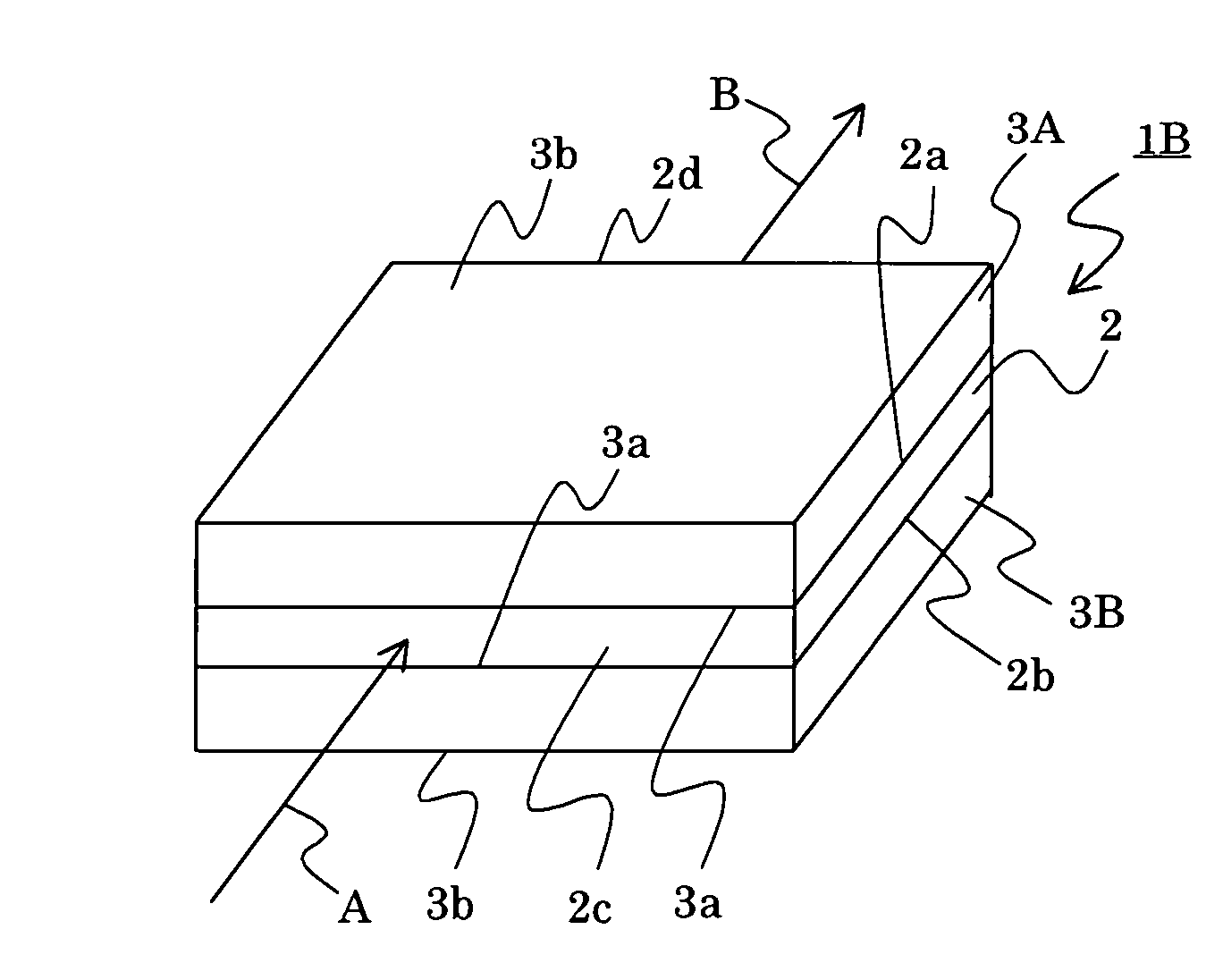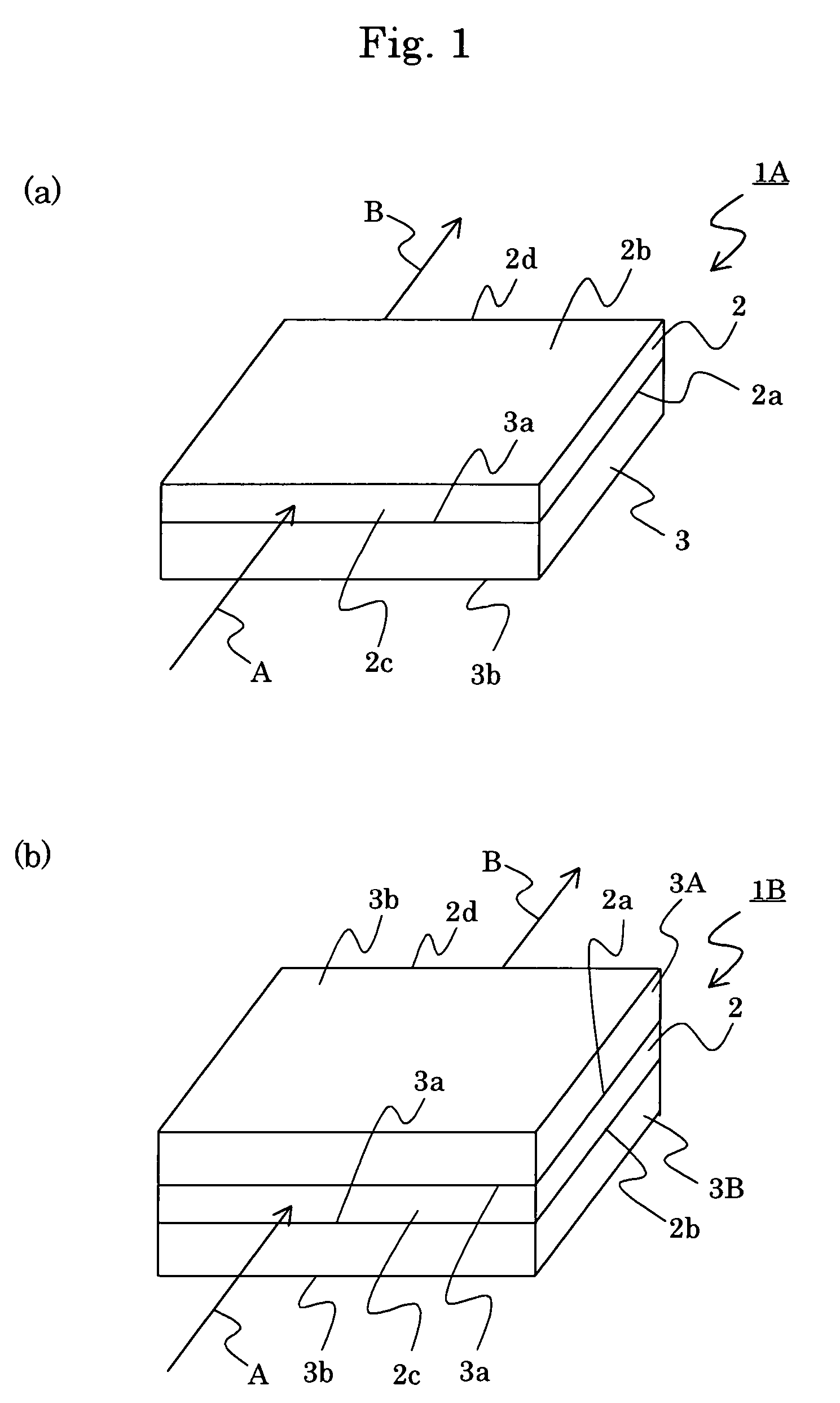Wavelength converting devices
a technology of converting devices and wavelengths, applied in the direction of instruments, light demodulation, non-linear optics, etc., can solve the problems of fluctuation and instability of the output of blue light from the device, and achieve the effects of improving the thermal uniformity and stability of light in the direction of the guiding wave, facilitating the handling of the device, and improving the strength of the devi
- Summary
- Abstract
- Description
- Claims
- Application Information
AI Technical Summary
Benefits of technology
Problems solved by technology
Method used
Image
Examples
example 1
[0040]A plate-shaped body 2 made of potassium lithium niobate, of Z-cut and having a length of 15 mm and width of 15 mm and thickness of 0.5 mm was prepared. The plate-shaped body was prepared by means of micro pull-down method. A supporting body 3 made of soda glass and having a length of 20 mm, a width of 20 mm and thickness of 1 mm was prepared. The joining faces of the substrate 2 and supporting body 3 were subjected to chemical machinery polishing to improve the flatness to a value of 0.5 μm or lower. An adhesive of thermosetting type was used to join them at 150° C. to obtain a joined sample “A.” The thickness of the adhesive layer between the substrate 2 and supporting body 3 was about 0.5 μm. The thus obtained joined sample “A” was cut by a dicer to obtain a chip having a length of 3.5 mm. Both end faces of the chip were subjected to optical polishing. The resulting chip was further cut with a dicer to obtain a device 1A having a width of 2 mm, a thickness of 1.5 mm and a le...
example 2
[0042]The joined sample “A” described in the example 1 was polished at another main face 2b (not joined) of the substrate 2 to obtain a joined sample “B” having a thickness of 1.3 mm. To the main face 2b (not joined) of the joined sample “B,” a soda glass substrate 3B having a length of 20 mm, a width of 20 mm and a thickness of 1.2 mm was adhered using a ultraviolet light curable resin to obtain a device 1B having a thickness of 2.5 mm. The thickness of the adhesive layer of the ultraviolet light curable resin was about 5 μm. The device 1B was used to perform an experiment of wavelength conversion according to the same procedure as Example 1. As a result, even when the average output of the fundamental light source was elevated to 10 W, fluctuation of the output power of the harmonic wave with blue light (wavelength of 457 nm) was not observed and the device oscillated with stability.
example 3
[0043]Devices were produced according to the same procedure as Example 1, except that the refractive indices of potassium lithium niobate crystal forming the plate-shaped body 2 so that the resulting devices can attain phase matching at −40, 0, 60, 100, 150 and 200° C., respectively, at a wavelength of 914 nm. The devices were held at the respective phase matching temperatures to perform experiments of wavelength conversion according to the same procedure as Example 1. As a result, even when the average output of the fundamental light source was elevated to 3 W, fluctuation of the output power of the harmonic wave with blue light (wavelength of 457 nm) was not observed and the device oscillated with stability.
PUM
| Property | Measurement | Unit |
|---|---|---|
| thermal conductivity | aaaaa | aaaaa |
| absorption coefficient | aaaaa | aaaaa |
| wavelength | aaaaa | aaaaa |
Abstract
Description
Claims
Application Information
 Login to View More
Login to View More - R&D
- Intellectual Property
- Life Sciences
- Materials
- Tech Scout
- Unparalleled Data Quality
- Higher Quality Content
- 60% Fewer Hallucinations
Browse by: Latest US Patents, China's latest patents, Technical Efficacy Thesaurus, Application Domain, Technology Topic, Popular Technical Reports.
© 2025 PatSnap. All rights reserved.Legal|Privacy policy|Modern Slavery Act Transparency Statement|Sitemap|About US| Contact US: help@patsnap.com


